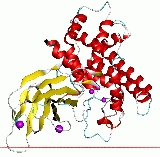
Zinc dependent phospholipase C
Encyclopedia
Zinc-dependent prokaryotic phospholipases C is a family of bacterial phospholipases C
, some of which are also known as alpha toxin
s.
Bacillus cereus
contains a monomeric phospholipase C (PLC) of 245 amino-acid residues. Although PLC prefers to acton phosphatidylcholine
, it also shows weak catalytic activity with sphingomyelin
and phosphatidylinositol
. Sequence studies have shown the protein to be similar both to alpha toxin fromClostridium perfringens
and Clostridium bifermentans
, a phospholipase C involved in haemolysis and cell rupture, and to lecithinase
from Listeria monocytogenes, which aids cell-to-cell spread by breaking down the 2-membrane vacuoles that surround the bacterium during transfer.
Each of these proteins is a zinc-dependent enzyme, binding 3 zinc ions per molecule. The enzymes catalyse the conversion of phosphatidylcholine and water to 1,2-diacylglycerol and choline phosphate.
In Bacillus cereus, there are nine residues known to be involved in binding the zinc ions: 5 His, 2 Asp, 1 Glu and 1 Trp. These residues are all conserved in the Clostridium alpha-toxin
.
Some examples of this enzyme contain a C-terminal sequence extension that contains a PLAT domain
which is thought to be involved in membrane localisation.
Phospholipase C
Phosphoinositide phospholipase C is a family of eukaryotic intracellular enzymes that play an important role in signal transduction processes. In general, this enzyme is denoted as Phospholipase C, although three other families of phospholipase C enzymes have been identified in bacteria and in...
, some of which are also known as alpha toxin
Alpha toxin
Alpha Toxin or alpha-toxin refers to several different protein toxins produced by bacteria. Alpha toxin may be:*Staphylococcus aureus alpha toxin, a membrane-disrupting toxin that creates pores causing hemolysis and tissue damage....
s.
Bacillus cereus
Bacillus cereus
Bacillus cereus is an endemic, soil-dwelling, Gram-positive, rod-shaped, beta hemolytic bacterium. Some strains are harmful to humans and cause foodborne illness, while other strains can be beneficial as probiotics for animals...
contains a monomeric phospholipase C (PLC) of 245 amino-acid residues. Although PLC prefers to acton phosphatidylcholine
Phosphatidylcholine
Phosphatidylcholines are a class of phospholipids that incorporate choline as a headgroup.They are a major component of biological membranes and can be easily obtained from a variety of readily available sources such as egg yolk or soy beans from which they are mechanically extracted or chemically...
, it also shows weak catalytic activity with sphingomyelin
Sphingomyelin
Sphingomyelin is a type of sphingolipid found in animal cell membranes, especially in the membranous myelin sheath that surrounds some nerve cell axons. It usually consists of phosphorylcholine and ceramide...
and phosphatidylinositol
Phosphatidylinositol
Phosphatidylinositol is a negatively charged phospholipid and a minor component in the cytosolic side of eukaryotic cell membranes....
. Sequence studies have shown the protein to be similar both to alpha toxin fromClostridium perfringens
Clostridium perfringens
Clostridium perfringens is a Gram-positive, rod-shaped, anaerobic, spore-forming bacterium of the genus Clostridium. C. perfringens is ever present in nature and can be found as a normal component of decaying vegetation, marine sediment, the intestinal tract of humans and other vertebrates,...
and Clostridium bifermentans
Clostridium bifermentans
Clostridium bifermentans is an anaerobic, motile, gram-positive bacterium....
, a phospholipase C involved in haemolysis and cell rupture, and to lecithinase
Lecithinase
Lecithinase is a type of phospholipase that acts upon lecithin.It can be produced by Clostridium perfringens or Listeria Monocytogenes . C. perfringens alpha toxin causes myonecrosis and hemolysis....
from Listeria monocytogenes, which aids cell-to-cell spread by breaking down the 2-membrane vacuoles that surround the bacterium during transfer.
Each of these proteins is a zinc-dependent enzyme, binding 3 zinc ions per molecule. The enzymes catalyse the conversion of phosphatidylcholine and water to 1,2-diacylglycerol and choline phosphate.
In Bacillus cereus, there are nine residues known to be involved in binding the zinc ions: 5 His, 2 Asp, 1 Glu and 1 Trp. These residues are all conserved in the Clostridium alpha-toxin
Clostridium perfringens alpha toxin
Clostridium perfringens alpha toxin is a toxin produced by the bacterium Clostridium perfringens and is responsible for gas gangrene and myonecrosis in infected tissues. The toxin also possesses hemolytic activity....
.
Some examples of this enzyme contain a C-terminal sequence extension that contains a PLAT domain
PLAT domain
PLAT domain is found in a variety of membrane or lipid associated proteins. It is called the PLAT domain or LH2 domain. The known structure...
which is thought to be involved in membrane localisation.

